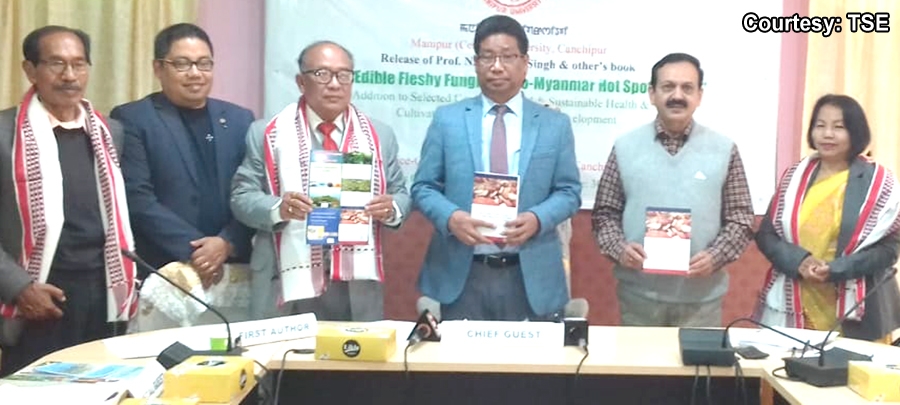Review of the book Wild Edible Fleshy Fungi of Indo-Myanmar hot spot region
|

BN Pande
This book (published by LAMBERT Academic publishing, Germany), presents extensive information on the “wild edible fleshy fungi of Indo–Myanmar Hot spot region (2022) that covers Value Addition to selected genera for food and sustainable Health and Artificial Cultivation for Socio – Economic Development”.
To review the book, I have critically gone through the book, which gives extensive and elaborative information on the “wild edible fleshy fungi of Indo- Myanmar Hot spot region”.
As a matter of fact, the book is authored by four authors (N Irabanta Singh, Th Chitaranjan Singh, Nivedita Lairenlakpam and M Babita Devi). However, the first author Professor Dr N Irabanta Singh is the senior author. Prof Dr NI Singh is a native of Imphal, Manipur State.
In 1982, he got PhD in Botany (Aerobiology) from Guwahati University, Guwahati (Assam). He continued his research work in the field of Aerobiology in the Indo –Myanmar border in Manipur State. He also reviewed ‘Fifty Years of Aerobiological Research in North East India’.
His search for alternate food for human consumption lead to spotting more than 40 (Forty) species of wild edible fleshy fungi and developed technology for cultivation of Pleurotus.
Important edible types were some species of Auricularia, Volvariella, Pluerotus, Schizophyllum, Tricholema gigantium, etc. Wide range in diversity was observed in regard to the fleshy fungi on the basis of the external and internal characteristics.
The content of the book is divided in six sections. Each Section is with respective chapters.
Section –1: Chapter I is Survey, collection and identification of Fleshy Fungi of Indo Myanmar
Hot Spot Region.
Section – 2: includes food value of certain Wild Edible Fungi like Auricularia and Pleurotus.
Section –3: Chapter 3, reveals i) phytochemical analysis and Anti oxidative behaviour of ethanolic extract of Pleurotus cornucopiae, ii) Chemical composition and Anti-oxidant Activity of Schizophyllum commune, iii) Anti-oxidative and Free Radical Scavenging Activity of ethanolic extracts of Lentinus edodes, iv) in vitro antioxidant activity and phytochemical analysis of ethanolic extracts of Lentinus conatus.
Section –4: Cultural studies on growth of certain wild edible fleshy fungi which covers
a) Cultural studies on growth on Lentinula lateritia
b) Artificial cultivation of Lentinula lateritia
c) Artificial cultivation of Auricularia.
d) Artificial production Technology of Auricularia delicata and
e) Fungal pathogen found in Auricularia spp. and their Management by plant
extracts.
f) Artificial cultivation of different Pleurotus spp. using certain Agro-forest
wastes as substrates for Sustainable Economic Development.
g) Artificial production of Termitomyces spp.;
h) Nutrient analysis of indigenous Termitomyces eurrhizus (Berk.) Heim.
Section –5: Mushrooms cultivation for Socio Economic Development of Rural Women.
It Covers the following chapters:
a) Vocational training programs for mushroom production,
b) Cost benefit analysis for mushroom cultivation,
c) Economic empowerment of rural women through Self–Help Group for
mushroom production.
Section –6: Wild Edible Fleshy-Past and Present.
Chapter -6 deals with general discussion
Chapter-7 is exclusively devoted for summary and conclusion with references.
Authors have meticulously suggested pertinent recommendations.
Comments based on the content of the Book are:
Edible fleshy fungi are among the best proteinases food. The survey, collection and identification of wild edible fleshy fungi is of prime importance for scientific and healthy human consumption. However, a wrong identification and selection may lead to mushroom poisoning which may be fatal. The collected species are to be processed, studied critically for their proper identification with the help of standard methods given by Springer (1986), Bilgrami et al (1987) etc.
A total of 6 (six) Pleurotus sp. were collected and identified. 6 (Six) species of locally available Pleurotus sp. were cultivated on different substrates (paddy straw, sugarcane bagasse, maize straw, pea straw, coir, pine needles, rice husk, banana pseudostem, etc.). They were analysed for the nutritional content.
Sr. author gave his meticulous statement that Mushroom cultivation is women friendly pursuit and is an agricultural enterprise which can be taken up in their leisure periods without disturbing their household work.
This book published by LAMBERT Academic Publishing, Germany has given extensive and intensive information on the Self-Help Group (SHG) which is a recent milestone in the upliftment of women, more pre precisely Mushroom Cultivation can uplift Socio Economic Status of the rural women and also educated unemployed youth.
The Reviewer is Ex. Professor and Head, Environmental Science. Dr. BAM University, Aurangabad (MS) and Professor Eminence, MGM, University, Aurangabad (MS)

